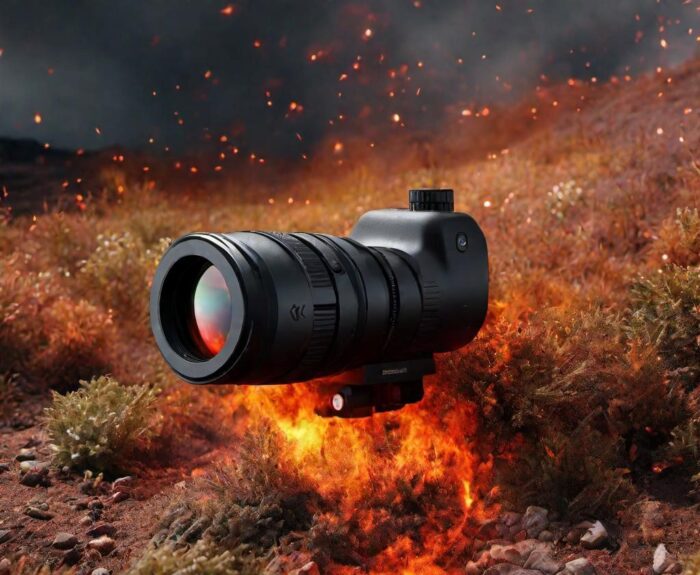Thermal monoculars have garnered attention for their unique ability to capture the unseen world of heat signatures. But where does this technology fit in the broader spectrum of light? Specifically, is a thermal monocular considered infrared? Let’s explore.

Understanding the Electromagnetic Spectrum
Before diving into the specifics of thermal monoculars, it’s crucial to have a grasp of the electromagnetic spectrum:
- Visible Light: This is the portion of the spectrum that the human eye can detect. It ranges from violet to red.
- Infrared (IR): Immediately adjacent to the visible light spectrum, infrared radiation lies just beyond the red light. It is further divided into near, mid, and far-infrared, based on wavelengths.
Principles of Infrared Radiation
At its core, the principle is straightforward: all objects emit radiation, and this radiation type and intensity are determined by the object’s temperature. Objects at ambient conditions primarily emit in the infrared range. Therefore, infrared is often equated with heat, though it’s essential to understand that not all infrared emissions translate to what we perceive as warmth.
Infrared and Heat Detection
- Heat as Radiation: All objects emit radiation, and the type of radiation is determined by the object’s temperature. Objects at room temperature emit primarily in the infrared range.
- Infrared Cameras vs. Thermal Cameras: While all thermal cameras are infrared cameras, not all infrared cameras are thermal. Standard IR cameras can see light in the infrared spectrum, but thermal cameras detect variations in IR radiation and translate them into thermal images.
The Mechanics of a Thermal Monocular
- Thermal Detection: A thermal monocular detects the differential heat (or IR radiation) emitted by objects. This is then converted into an electronic signal, which is processed to produce a thermal image on a display.
- Infrared Sensitivity: The thermal sensors in a monocular are sensitive to specific infrared wavelengths, typically in the far-infrared range, which corresponds to temperatures seen in everyday environments.
From Warfare to Wildlife
Initially, the development of thermal imaging was driven by military applications. Night vision and target detection were critical in combat scenarios. However, as the technology matured and costs reduced, civilian sectors began to adopt and adapt these tools. Today, thermal monoculars are used in diverse fields, from wildlife observation and hunting to search and rescue operations.
How Thermal Differs from Traditional Infrared Imaging
In the vast realm of imaging technologies, the distinctions between different methods can sometimes blur. Both thermal imaging and traditional infrared imaging operate within the invisible-to-humans infrared spectrum, but their functioning, applications, and outcomes significantly differ. It’s essential to delve deeper into these differences to appreciate the unique capabilities and limitations of each.
The Foundations: Understanding the Electromagnetic Spectrum
The electromagnetic spectrum is a continuum of all electromagnetic waves arranged according to frequency and wavelength. Our eyes are attuned to a tiny fraction of this spectrum, which we perceive as visible light. Immediately beyond this range is the infrared spectrum, divided into three primary segments: Near-Infrared (NIR), which is closest to visible light and commonly used in electronic device remotes; Mid-Infrared (MIR), often employed in telecommunication systems; and Far-Infrared (FIR), which is most associated with thermal radiation and is the domain of thermal imaging.
Diving into Traditional Infrared Imaging
Traditional infrared imaging, often simply termed as infrared imaging, is predominantly concerned with the near-infrared range. Cameras operating in this range require some amount of ambient light, typically provided by infrared LEDs, to cast light onto the subject. The camera then captures the infrared light reflected off objects. This method is quite popular in security applications, where nighttime surveillance is necessary. The added advantage is that the infrared light used for illumination is invisible to the human eye, ensuring the scene remains undisturbed. When viewing images from traditional infrared cameras, they generally look like monochromatic or grayscale versions of standard photographs, where the contrast is based on the amount of reflected infrared light.
So, Is a Thermal Monocular Infrared?
Yes, a thermal monocular is an infrared device. It operates by detecting infrared radiation (heat) from objects and then translating those differences into visual images. However, it’s important to differentiate between devices that simply capture IR light and those, like the thermal monocular, that interpret thermal differences based on infrared emissions.
Conclusion
The fascinating world of thermal imaging resides within the realm of the infrared. Thermal monoculars, with their ability to detect and display heat signatures, are unequivocally infrared devices. They offer a unique perspective on the environment, revealing the unseen and granting users insights beyond the capabilities of the human eye.
